The Books of To-day and the Books of To-morrow, June 1904
ACADEMY NOTES. 1
No. 119 (‘Sir William Emerson’).—Mr. Shannon’s 2 clever study of the perplexed linendraper. What need is there of a catalogue? How clearly we can read the whole story in the man’s expression. We know that he could have declared that he put that yard-measure down on that very spot. And now it is gone! Customers are becoming impatient: the shopwalker is growing stern: and still the missing article refuses to be found. A pathetic study.
No. 194 (‘The Right Hon. Joseph Chamberlain, M.P.’).—Mr. Herkomer 3 represents Mr. Chamberlain as he appears when somebody has said ‘Fiscal Reform!’ suddenly in his presence. His very eyeglass seems to snort forth damaging arguments.
No. 199 (‘The Golden Fleece’). 4 —‘The Unwilling Bather’ is a spirited work. The foolish boy, having gone so far as to strip for his morning dip, shrinks at the last moment, and it requires all the persuasion of the bathing-machine woman and the efforts of her muscular assistants to induce him to make the plunge. The face of the bathing-machine woman is a masterly study. ‘It is quite warm,’ she is saying: but her face belies her words.
No. 209 (‘Arthur’).—‘The New Hat.’ A gentleman wandering by the sea has found a crown. The artist has portrayed him at the moment when he realises that it is just his size and as new.
No. 377 (‘The Talisman’). 5 —The rigours of the English summer are neatly satirised. The dissatisfied face of the lady shows clearly that she is perfectly well aware that her costume is too diaphanous for June.
American visitors crowd to No. 397 (‘The Marquess of Londonderry’), Mr. Sargent’s representation of ‘How Society amuses itself: or Baseball among the Upper Ten.’ The Marquess of Londonderry is at the bat, and Mr. W. C. Beaumont officiates as catcher. 6
No. 457 (‘The Gambler’s Victim’). 7 —‘No more Bridge to-night.’ The guests have gone, and the host is left alone to ask himself for the hundredth time what could have induced him to trump his partner’s trick and so lose both the game and the rubber. The bitterest reflection of all is that he sees now—too late, alas!—just what he ought to have played.
No. 473 (‘M. H. Spielmann, Esq.’).—‘Editor surprised by Contributor’ represents Mr. M. H. Spielmann, 8 the Editor of the Magazine of Art, disturbed in his sanctum by a gentleman who thought that, as he happened to be passing, he would bring a little thing of his own in person instead of sending it by post. The Editor’s expression bodes no good for the office-boy who admitted the visitor.
No. 540 (‘Mammon’). 9 —‘Off to the Fancy Dress Ball’ shows us the squire on his way to the local costume ball in aid of the organ fund. The villagers crowd round to admire his golden armour, and wager as to what he is supposed to be.
We have another bathing picture in 553 (‘Moses Viewing the Promised Land’). 10 The old gentleman stands on the brink, looking at the water with mixed feelings. He knows that a dip will do him a world of good, but the morning air is keen, and he wraps his bath robe more closely round him as he meditates.
No. 723 (‘Psyche’).—‘Dressing for Dinner’ is pathetic. A young lady has arrived at a country house, only to find that her boxes have gone astray, and that she has positively nothing to wear except an assortment of pearl necklaces. As her hostess is notoriously strict in these matters, the poor girl is at her wits’ end.
No. 829 (‘Got Him’).—‘The Boyhood of Hackenschmidt.’ 11 The famous wrestler is, even at that early age, engaged in his favourite pursuit.
Altogether, the Academy this year is up to the well-known standard. In connection with the exhibition it is interesting to note, as Mr. Walter Emanuel 12 has pointed out, that a great many of our oldest Academicians started life as artists.
Printed unsigned; entered by Wodehouse in Money Received for Literary Work.
All the paintings referred to in this piece were indeed exhibited at the 1904 Summer Exhibition of the Royal Academy of Arts: the numbers and titles shown in bold type are those used for the exhibition; alternative titles (in normal type) are Wodehouse’s own and refer to his imaginative reinterpretations of the paintings. Thus, for example, Arthur Wardle’s ‘Got Him’ (No. 829) does not depict the boyhood of the wrestler Georg Hackenschmidt; that is just Wodehouse’s fanciful interpretation.
If you are viewing this page in a narrow browser window, the images may be scaled to a smaller size, and you may be able to enlarge them with a View Image command, often available by right-clicking on the image.
2
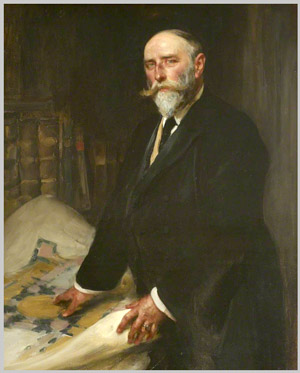 Sir James Jebusa Shannon, RA (1862–1923) was an American-born portrait
painter. Sir William Emerson (1843–1924) was an English architect, most
of whose completed buildings are in India, the best known being the Victoria
Memorial, Calcutta. Emerson had no connection with the linen trade, though
he was the son of a silk manufacturer.
Sir James Jebusa Shannon, RA (1862–1923) was an American-born portrait
painter. Sir William Emerson (1843–1924) was an English architect, most
of whose completed buildings are in India, the best known being the Victoria
Memorial, Calcutta. Emerson had no connection with the linen trade, though
he was the son of a silk manufacturer.
3
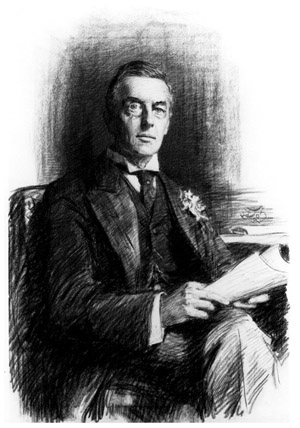 Sir Hubert von Herkomer (1849–1914) was a Bavarian-born painter and illustrator,
who lived in England from the age of eight years. Although he painted in
other genres, Herkomer became best known for his portraits, from which
he earned a great deal of money; he was noted for his habit of talking
to his sitters to animate their expressions.
Sir Hubert von Herkomer (1849–1914) was a Bavarian-born painter and illustrator,
who lived in England from the age of eight years. Although he painted in
other genres, Herkomer became best known for his portraits, from which
he earned a great deal of money; he was noted for his habit of talking
to his sitters to animate their expressions.
Joseph Chamberlain was a Liberal (later Liberal Unionist) politician. He
served as Colonial Secretary from 1895 until September 1903, when he resigned
from the Cabinet in order to be free to campaign for a programme of tariff
reform and “Imperial Preference” (what Wodehouse refers to
as “Fiscal Reform”).
4
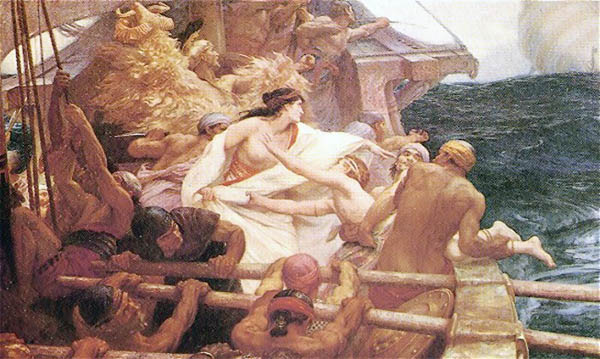 ‘The Golden Fleece,’ by Herbert James Draper (1864–1920), depicts
a scene from Greek mythology. Medea, daughter of King Aeetes, has helped
Jason to rob her father of a Golden Fleece and the pair are fleeing by
sea, pursued by the king. Draper’s painting was exhibited with the
following text: Now when they were hotly pursued by the King her father
Medea did cast her brother into the sea to drown, that the king should
rescue his son’s body and the pursuit be delayed. The painting
depicts Medea, assisted by two sailors, throwing her naked brother overboard,
while he struggles to avoid his fate.
‘The Golden Fleece,’ by Herbert James Draper (1864–1920), depicts
a scene from Greek mythology. Medea, daughter of King Aeetes, has helped
Jason to rob her father of a Golden Fleece and the pair are fleeing by
sea, pursued by the king. Draper’s painting was exhibited with the
following text: Now when they were hotly pursued by the King her father
Medea did cast her brother into the sea to drown, that the king should
rescue his son’s body and the pursuit be delayed. The painting
depicts Medea, assisted by two sailors, throwing her naked brother overboard,
while he struggles to avoid his fate.
Charles E. Butler (1864–1933) painted ‘King Arthur.’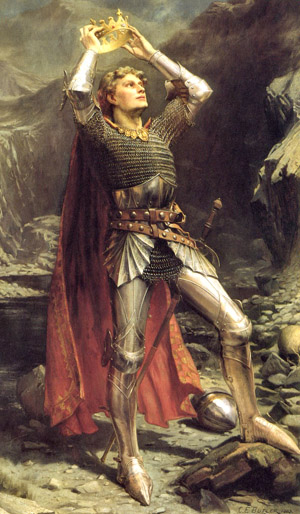
5
‘The Talisman’ was painted by Harry E. J. Browne. One report describes it as “Girl draped in transparent black muslin with a blue gem dependent from her necklet.”
6
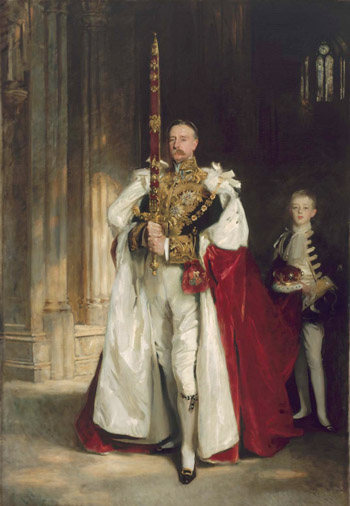 This refers to an oil painting by John Singer Sargent (1856–1925) entitled
‘Charles Stewart Sixth Marquess of Londonderry Carrying the Great
Sword of State at the Coronation of King Edward VII, August 1902, and Mr.
W. C. Beaumont His Page on That Occasion.’ The painting was purchased
in July 2003 by the Boston, Massachusetts, Museum of Fine Arts.
This refers to an oil painting by John Singer Sargent (1856–1925) entitled
‘Charles Stewart Sixth Marquess of Londonderry Carrying the Great
Sword of State at the Coronation of King Edward VII, August 1902, and Mr.
W. C. Beaumont His Page on That Occasion.’ The painting was purchased
in July 2003 by the Boston, Massachusetts, Museum of Fine Arts.
7
‘The Gambler’s Victim’ was exhibited by one Arthur C. Cooke. One report describes it as “Dejected young roué at daybreak gazing at card-table.”
8
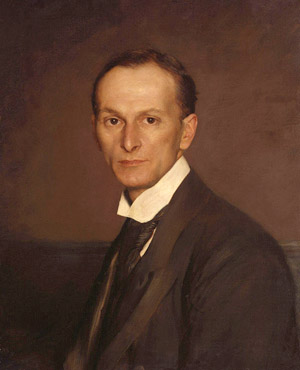 Marion Harry Spielmann (1858–1948) was an English art and literary critic,
whose published works included studies of the artists John Everett Millais
and John Ruskin, and a history of Punch magazine; he also wrote
the Introduction to the catalogue for the 1904 exhibition. His portrait
was painted by John H. F. Bacon, ARA, and depicts Spielmann seated at his
desk, looking straight at the viewer, with an expression of
mild irritation on his face.
Marion Harry Spielmann (1858–1948) was an English art and literary critic,
whose published works included studies of the artists John Everett Millais
and John Ruskin, and a history of Punch magazine; he also wrote
the Introduction to the catalogue for the 1904 exhibition. His portrait
was painted by John H. F. Bacon, ARA, and depicts Spielmann seated at his
desk, looking straight at the viewer, with an expression of
mild irritation on his face.
9
‘Mammon’ was painted by Robert Sauber (1868–1936), a British illustrator, portrait and genre artist who was best known for his cover illustrations for magazines and periodicals. “Mammon, typified by a knight in gold armour, rides rough-shod through a city. Courage is overthrown, and Love itself is about to be trampled. Poetry, art, and music, with bowed heads, lend their presence to the triumphant entry. Labour and poverty wait for Justice and Death, who follow closely the rider.”
10
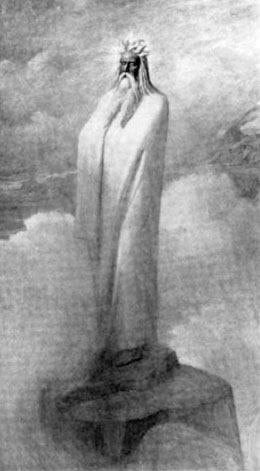 ‘Moses Viewing the Promised Land’ was one of four paintings
exhibited by Sir William Blake Richmond, RA (1842–1921), a distinguished
painter and professor of painting at the Royal Academy. The image at right is of the picture before it was finished, but depicts the composition of “a white robed figure standing on a solitary peak of Pisgah. Rose-tinged mists disperse at dawn, and rolling aside, disclose distant blue mountain crags.”
‘Moses Viewing the Promised Land’ was one of four paintings
exhibited by Sir William Blake Richmond, RA (1842–1921), a distinguished
painter and professor of painting at the Royal Academy. The image at right is of the picture before it was finished, but depicts the composition of “a white robed figure standing on a solitary peak of Pisgah. Rose-tinged mists disperse at dawn, and rolling aside, disclose distant blue mountain crags.”
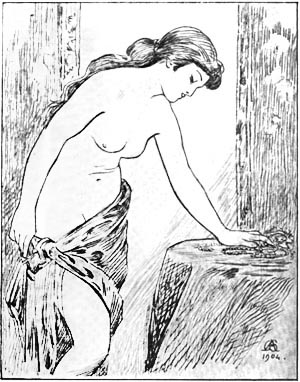
The only available representation of ‘Psyche’ by G. A. Storey (1834–1919) seems to be this visitor’s sketch of the composition, reprinted in the official Academy Notes of the Royal Academy.
11
Estonian-born Georg Hackenschmidt (1878–1968) was a professional wrestler.
In 1902 he defeated Tom Cannon to win the European Greco-Roman Heavyweight
Championship, a title that was, at that time, effectively that of World
Champion.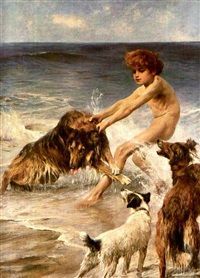 ‘Got Him!!!’ was exhibited by Arthur Wardle (1864–1949), who
had a great popular reputation as a painter of wild animals, especially
the larger cats.
‘Got Him!!!’ was exhibited by Arthur Wardle (1864–1949), who
had a great popular reputation as a painter of wild animals, especially
the larger cats.
12
Walter Lewis Emanuel (1869–1915) was, from 1902, the author of the “Charivaria” column in the weekly magazine Punch (having been brought to the notice of the editor of Punch by M. H. Spielmann (see above), as well as contributing sketches to periodicals such as The Pall Mall Gazette. He was the author of a number of books, including two about dogs that were illustrated by Cecil Aldin.
 Madame Eulalie’s Rare Plums
Madame Eulalie’s Rare Plums